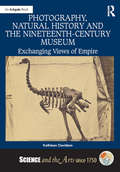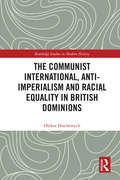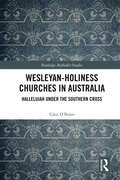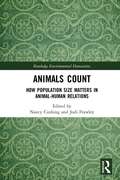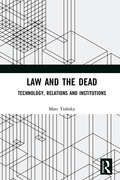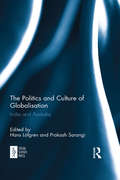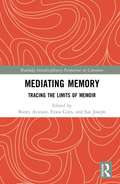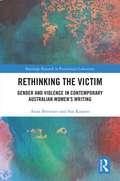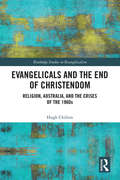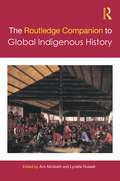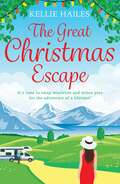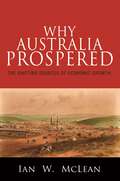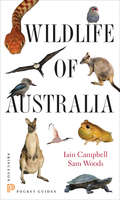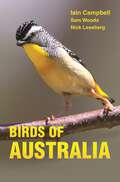- Table View
- List View
Photography, Natural History and the Nineteenth-Century Museum: Exchanging Views of Empire (Science and the Arts since 1750)
by Kathleen DavidsonThe Victorian era heralded an age of transformation in which momentous changes in the field of natural history coincided with the rise of new visual technologies. Concurrently, different parts of the British Empire began to more actively claim their right to being acknowledged as indispensable contributors to knowledge and the progress of empire. This book addresses the complex relationship between natural history and photography from the 1850s to the 1880s in Britain and its colonies: Australia, New Zealand and, to a lesser extent, India. Coinciding with the rise of the modern museum, photography’s arrival was timely, and it rapidly became an essential technology for recording and publicising rare objects and valuable collections. Also during this period, the medium assumed a more significant role in the professional practices and reputations of naturalists than has been previously recognized, and it figured increasingly within the expanding specialized networks that were central to the production and dissemination of new knowledge. In an interrogation that ranges from the first forays into museum photography and early attempts to document collecting expeditions to the importance of traditional and photographic portraiture for the recognition of scientific discoveries, this book not only recasts the parameters of what we actually identify as natural history photography in the Victorian era but also how we understand the very structure of empire in relation to this genre at that time.
The Communist International, Anti-Imperialism and Racial Equality in British Dominions (Routledge Studies in Modern History)
by Oleksa DrachewychThis book analyzes the stance of international communism towards nationality, anti-colonialism, and racial equality as defined by the Communist International (Comintern) during the interwar period. Central to the volume is a comparative analysis of the communist parties of three British dominions, South Africa, Canada and Australia, demonstrating how each party attempted to follow Moscow’s lead and how each party produced its own attempts to deal with these issues locally, while considering the limits of their own agency within the movement at large.
The Communist International, Anti-Imperialism and Racial Equality in British Dominions (Routledge Studies in Modern History)
by Oleksa DrachewychThis book analyzes the stance of international communism towards nationality, anti-colonialism, and racial equality as defined by the Communist International (Comintern) during the interwar period. Central to the volume is a comparative analysis of the communist parties of three British dominions, South Africa, Canada and Australia, demonstrating how each party attempted to follow Moscow’s lead and how each party produced its own attempts to deal with these issues locally, while considering the limits of their own agency within the movement at large.
Wesleyan-Holiness Churches in Australia: Hallelujah under the Southern Cross (Routledge Methodist Studies Series)
by Glen O'BrienMost Wesleyan-Holiness churches started in the US, developing out of the Methodist roots of the nineteenth-century Holiness Movement. The American origins of the Holiness movement have been charted in some depth, but there is currently little detail on how it developed outside of the US. This book seeks to redress this imbalance by giving a history of North American Wesleyan-Holiness churches in Australia, from their establishment in the years following the Second World War, as well as of The Salvation Army, which has nineteenth-century British origins. It traces the way some of these churches moved from marginalised sects to established denominations, while others remained small and isolated. Looking at The Church of God (Anderson), The Church of God (Cleveland), The Church of the Nazarene, The Salvation Army, and The Wesleyan Methodist Church in Australia, the book argues two main points. Firstly, it shows that rather than being American imperialism at work, these religious expressions were a creative partnership between like-minded evangelical Christians from two modern nations sharing a general cultural similarity and set of religious convictions. Secondly, it demonstrates that it was those churches that showed the most willingness to be theologically flexible, even dialling down some of their Wesleyan distinctiveness, that had the most success. This is the first book to chart the fascinating development of Holiness churches in Australia. As such, it will be of keen interest to scholars of Wesleyans and Methodists, as well as religious history and the sociology of religion more generally.
Wesleyan-Holiness Churches in Australia: Hallelujah under the Southern Cross (Routledge Methodist Studies Series)
by Glen O'BrienMost Wesleyan-Holiness churches started in the US, developing out of the Methodist roots of the nineteenth-century Holiness Movement. The American origins of the Holiness movement have been charted in some depth, but there is currently little detail on how it developed outside of the US. This book seeks to redress this imbalance by giving a history of North American Wesleyan-Holiness churches in Australia, from their establishment in the years following the Second World War, as well as of The Salvation Army, which has nineteenth-century British origins. It traces the way some of these churches moved from marginalised sects to established denominations, while others remained small and isolated. Looking at The Church of God (Anderson), The Church of God (Cleveland), The Church of the Nazarene, The Salvation Army, and The Wesleyan Methodist Church in Australia, the book argues two main points. Firstly, it shows that rather than being American imperialism at work, these religious expressions were a creative partnership between like-minded evangelical Christians from two modern nations sharing a general cultural similarity and set of religious convictions. Secondly, it demonstrates that it was those churches that showed the most willingness to be theologically flexible, even dialling down some of their Wesleyan distinctiveness, that had the most success. This is the first book to chart the fascinating development of Holiness churches in Australia. As such, it will be of keen interest to scholars of Wesleyans and Methodists, as well as religious history and the sociology of religion more generally.
Animals Count: How Population Size Matters in Animal-Human Relations (Routledge Environmental Humanities)
by Nancy Cushing Jodi FrawleyWhether their populations are perceived as too large, just right, too small or non-existent, animal numbers matter to the humans with whom they share environments. Animals in the right numbers are accepted and even welcomed, but when they are seen to deviate from the human-declared set point, they become either enemies upon whom to declare war or victims to be protected. In this edited volume, leading and emerging scholars investigate for the first time the ways in which the size of an animal population impacts how they are viewed by humans and, conversely, how human perceptions of populations impact animals. This collection explores the fortunes of amphibians, mammals, insects and fish whose numbers have created concern in settler Australia and examines shifts in these populations between excess, abundance, equilibrium, scarcity and extinction. The book points to the importance of caution in future campaigns to manipulate animal populations, and demonstrates how approaches from the humanities can be deployed to bring fresh perspectives to understandings of how to live alongside other animals.
Animals Count: How Population Size Matters in Animal-Human Relations (Routledge Environmental Humanities)
by Nancy Cushing Jodi FrawleyWhether their populations are perceived as too large, just right, too small or non-existent, animal numbers matter to the humans with whom they share environments. Animals in the right numbers are accepted and even welcomed, but when they are seen to deviate from the human-declared set point, they become either enemies upon whom to declare war or victims to be protected. In this edited volume, leading and emerging scholars investigate for the first time the ways in which the size of an animal population impacts how they are viewed by humans and, conversely, how human perceptions of populations impact animals. This collection explores the fortunes of amphibians, mammals, insects and fish whose numbers have created concern in settler Australia and examines shifts in these populations between excess, abundance, equilibrium, scarcity and extinction. The book points to the importance of caution in future campaigns to manipulate animal populations, and demonstrates how approaches from the humanities can be deployed to bring fresh perspectives to understandings of how to live alongside other animals.
Law and the Dead: Technology, Relations and Institutions
by Marc TrabskyThe governance of the dead in the eighteenth and nineteenth centuries gave rise to a new arrangement of thanato-politics in the West. Legal, medical and bureaucratic institutions developed innovative technologies for managing the dead, maximising their efficacy and exploiting their vitality. Law and the Dead writes a history of their institutional life in the nineteenth and twentieth centuries. With a particular focus on the technologies of the death investigation process, including place-making, the forensic gaze, bureaucratic manuals, record-keeping and radiography, this book examines how the dead came to be incorporated into legal institutions in the modern era. Drawing on the writings of philosophers, historians and legal theorists, it offers tools for thinking through how the dead dwell in law, how their lives persist through the conduct of office, and how coroners assume responsibility for taking care of the dead. This historical and interdisciplinary book offers a provocative challenge to conventional thinking about the sequestration of the dead in the nineteenth and twentieth centuries. It asks the reader to think through and with legal institutions when writing a history of the dead, and to trace the important role assumed by coroners in the governance of the dead. This book will be of interest to scholars working in law, history, sociology and criminology.
Law and the Dead: Technology, Relations and Institutions
by Marc TrabskyThe governance of the dead in the eighteenth and nineteenth centuries gave rise to a new arrangement of thanato-politics in the West. Legal, medical and bureaucratic institutions developed innovative technologies for managing the dead, maximising their efficacy and exploiting their vitality. Law and the Dead writes a history of their institutional life in the nineteenth and twentieth centuries. With a particular focus on the technologies of the death investigation process, including place-making, the forensic gaze, bureaucratic manuals, record-keeping and radiography, this book examines how the dead came to be incorporated into legal institutions in the modern era. Drawing on the writings of philosophers, historians and legal theorists, it offers tools for thinking through how the dead dwell in law, how their lives persist through the conduct of office, and how coroners assume responsibility for taking care of the dead. This historical and interdisciplinary book offers a provocative challenge to conventional thinking about the sequestration of the dead in the nineteenth and twentieth centuries. It asks the reader to think through and with legal institutions when writing a history of the dead, and to trace the important role assumed by coroners in the governance of the dead. This book will be of interest to scholars working in law, history, sociology and criminology.
The Politics and Culture of Globalisation: India and Australia
by Hans Löfgren Prakash SarangiWe experience the culture of globalisation every time we visit a Tandoori restaurant in Chicago, or a Pizza Hut in Hyderabad, or as we watch Bollywood films in Australia. Globalisation is a label used for a wide range of political, social and cultural phenomena, many of which are explored in this volume. The Politics and Culture of Globalisation: India and Australia brings together Indian and Australian experts in the fields of political science, international relations, philosophy, cultural theory and political economy. Its timeliness and unifying theme derive from comparisons between Indian and Australian perspectives, and analyses by Australian writers on developments in India. Indian-Australian relations are explored in several chapters. The neo-liberal form of globalisation is a key focus of critique in this volume. Several chapters examine the search for alternative forms of governance as the nation-state undergoes profound change due to global interconnectedness.
The Politics and Culture of Globalisation: India and Australia
by Hans Löfgren Prakash SarangiWe experience the culture of globalisation every time we visit a Tandoori restaurant in Chicago, or a Pizza Hut in Hyderabad, or as we watch Bollywood films in Australia. Globalisation is a label used for a wide range of political, social and cultural phenomena, many of which are explored in this volume. The Politics and Culture of Globalisation: India and Australia brings together Indian and Australian experts in the fields of political science, international relations, philosophy, cultural theory and political economy. Its timeliness and unifying theme derive from comparisons between Indian and Australian perspectives, and analyses by Australian writers on developments in India. Indian-Australian relations are explored in several chapters. The neo-liberal form of globalisation is a key focus of critique in this volume. Several chapters examine the search for alternative forms of governance as the nation-state undergoes profound change due to global interconnectedness.
Mediating Memory: Tracing the Limits of Memoir (Routledge Interdisciplinary Perspectives on Literature)
by Bunty Avieson Fiona Giles Sue JosephThe argument has been made that memoir reflects and augments the narcissistic tendencies of our neo-liberal age. Mediating Memory: Tracing the Limits of Memoir challenges and dismantles that assumption. Focusing on the history, theory and practice of memoir writing, editors Bunty Avieson, Fiona Giles and Sue Joseph provide a thorough and cutting-edge examination of memoir through the lenses of ethics, practice and innovation. By investigating memoir across cultural boundaries, in its various guises, and tracing its limits, the editors convincingly demonstrate the plurality of ways in which memoir is helping us make sense of who we are, who we were and the influences that shape us along the way.
Rethinking the Victim: Gender and Violence in Contemporary Australian Women's Writing (Routledge Research in Postcolonial Literatures)
by Anne Brewster Sue KossewThis book is the first to examine gender and violence in Australian literature. It argues that literary texts by Australian women writers offer unique ways of understanding the social problem of gendered violence, bringing this often private and suppressed issue into the public sphere. It draws on the international field of violence studies to investigate how Australian women writers challenge the victim paradigm and figure women’s agencies. In doing so, it provides a theoretical context for the increasing number of contemporary literary works by Australian women writers that directly address gendered violence, an issue that has taken on urgent social and political currency. By analysing Australian women’s literary representations of gendered violence, this book rethinks victimhood and agency, particularly from a feminist perspective. One of its major innovations is that it examines mainstream Australian women’s writing alongside that of Indigenous and minoritised women. In doing so it provides insights into the interconnectedness of Australia’s diverse settler, Indigenous and diasporic histories in chapters that examine intimate partner violence, violence against Indigenous women and girls, family violence and violence against children, and the war and political violence.
Rethinking the Victim: Gender and Violence in Contemporary Australian Women's Writing (Routledge Research in Postcolonial Literatures)
by Anne Brewster Sue KossewThis book is the first to examine gender and violence in Australian literature. It argues that literary texts by Australian women writers offer unique ways of understanding the social problem of gendered violence, bringing this often private and suppressed issue into the public sphere. It draws on the international field of violence studies to investigate how Australian women writers challenge the victim paradigm and figure women’s agencies. In doing so, it provides a theoretical context for the increasing number of contemporary literary works by Australian women writers that directly address gendered violence, an issue that has taken on urgent social and political currency. By analysing Australian women’s literary representations of gendered violence, this book rethinks victimhood and agency, particularly from a feminist perspective. One of its major innovations is that it examines mainstream Australian women’s writing alongside that of Indigenous and minoritised women. In doing so it provides insights into the interconnectedness of Australia’s diverse settler, Indigenous and diasporic histories in chapters that examine intimate partner violence, violence against Indigenous women and girls, family violence and violence against children, and the war and political violence.
Evangelicals and the End of Christendom: Religion, Australia and the Crises of the 1960s (Routledge Studies in Evangelicalism)
by Hugh ChiltonExploring the response of evangelicals to the collapse of ‘Greater Christian Britain’ in Australia in the long 1960s, this book provides a new religious perspective to the end of empire and a fresh national perspective to the end of Christendom. In the turbulent 1960s, two foundations of the Western world rapidly and unexpectedly collapsed. ‘Christendom’, marked by the dominance of discursive Christianity in public culture, and ‘Greater Britain’, the powerful sentimental and strategic union of Britain and its settler societies, disappeared from the collective mental map with startling speed. To illuminate these contemporaneous global shifts, this book takes as a case study the response of Australian evangelical Christian leaders to the cultural and religious crises encountered between 1959 and 1979. Far from being a narrow national study, this book places its case studies in the context of the latest North American and European scholarship on secularisation, imperialism and evangelicalism. Drawing on a wide range of archival sources, it examines critical figures such as Billy Graham, Fred Nile and Hans Mol, as well as issues of empire, counter-cultural movements and racial and national identity. This study will be of particular interest to any scholar of Evangelicalism in the twentieth century. It will also be a useful resource for academics looking into the wider impacts of the decline of Christianity and the British Empire in Western civilisation.
Evangelicals and the End of Christendom: Religion, Australia and the Crises of the 1960s (Routledge Studies in Evangelicalism)
by Hugh ChiltonExploring the response of evangelicals to the collapse of ‘Greater Christian Britain’ in Australia in the long 1960s, this book provides a new religious perspective to the end of empire and a fresh national perspective to the end of Christendom. In the turbulent 1960s, two foundations of the Western world rapidly and unexpectedly collapsed. ‘Christendom’, marked by the dominance of discursive Christianity in public culture, and ‘Greater Britain’, the powerful sentimental and strategic union of Britain and its settler societies, disappeared from the collective mental map with startling speed. To illuminate these contemporaneous global shifts, this book takes as a case study the response of Australian evangelical Christian leaders to the cultural and religious crises encountered between 1959 and 1979. Far from being a narrow national study, this book places its case studies in the context of the latest North American and European scholarship on secularisation, imperialism and evangelicalism. Drawing on a wide range of archival sources, it examines critical figures such as Billy Graham, Fred Nile and Hans Mol, as well as issues of empire, counter-cultural movements and racial and national identity. This study will be of particular interest to any scholar of Evangelicalism in the twentieth century. It will also be a useful resource for academics looking into the wider impacts of the decline of Christianity and the British Empire in Western civilisation.
The Routledge Companion to Global Indigenous History (Routledge Companions)
by Ann McGrath Lynette RussellThe Routledge Companion to Global Indigenous History presents exciting new innovations in the dynamic field of Indigenous global history while also outlining ethical, political, and practical research. Indigenous histories are not merely concerned with the past but have resonances for the politics of the present and future, ranging across vast geographical distances and deep time periods. The volume starts with an introduction that explores definitions of Indigenous peoples, followed by six thematic sections which each have a global spread: European uses of history and the positioning of Indigenous people as history’s outsiders; their migrations and mobilities; colonial encounters; removals and diasporas; memory, identities, and narratives; deep histories and pathways towards future Indigenous histories that challenge the nature of the history discipline itself. This book illustrates the important role of Indigenous history and Indigenous knowledges for contemporary concerns, including climate change, spirituality and religious movements, gender negotiations, modernity and mobility, and the meaning of ‘nation’ and the ‘global’. Reflecting the state of the art in Indigenous global history, the contributors suggest exciting new directions in the field, examine its many research challenges and show its resonances for a global politics of the present and future. This book is invaluable reading for students in both undergraduate and postgraduate Indigenous history courses.
The Routledge Companion to Global Indigenous History (Routledge Companions)
by Ann McGrath Lynette RussellThe Routledge Companion to Global Indigenous History presents exciting new innovations in the dynamic field of Indigenous global history while also outlining ethical, political, and practical research. Indigenous histories are not merely concerned with the past but have resonances for the politics of the present and future, ranging across vast geographical distances and deep time periods. The volume starts with an introduction that explores definitions of Indigenous peoples, followed by six thematic sections which each have a global spread: European uses of history and the positioning of Indigenous people as history’s outsiders; their migrations and mobilities; colonial encounters; removals and diasporas; memory, identities, and narratives; deep histories and pathways towards future Indigenous histories that challenge the nature of the history discipline itself. This book illustrates the important role of Indigenous history and Indigenous knowledges for contemporary concerns, including climate change, spirituality and religious movements, gender negotiations, modernity and mobility, and the meaning of ‘nation’ and the ‘global’. Reflecting the state of the art in Indigenous global history, the contributors suggest exciting new directions in the field, examine its many research challenges and show its resonances for a global politics of the present and future. This book is invaluable reading for students in both undergraduate and postgraduate Indigenous history courses.
The Great Christmas Escape
by Kellie HailesIt's time to swap mistletoe and mince pies for the adventure of a lifetime! Sara's life has been in a bit of a rut. Lately, her job as a photographer has just meant taking photos of happy couples and families all day before returning to her empty flat. And while she normally loves Christmas with her family, this year a part of her just wants to run away. So when her ex-husband Fin gets in touch with a wild idea - a joint work trip to New Zealand - she knows it's crazy... but she says yes!A celebrated travel blogger, Fin has made a career out of following his bliss. As much as he loves Sara, the steady family life she's always wanted is not one he can give her. This trip together is his one chance to win her back. But can he convert her to his impulsive lifestyle? There's only one way to find out. As the two explore the stunning sights and thrills of New Zealand, they're about to discover there's so much more to each other than they ever realised...A Christmas romcom like no other, The Great Christmas Escape by Kellie Hailes is the perfect getaway read this year...
Why Australia Prospered: The Shifting Sources of Economic Growth
by Ian W. McleanThis book is the first comprehensive account of how Australia attained the world's highest living standards within a few decades of European settlement, and how the nation has sustained an enviable level of income to the present. Why Australia Prospered is a fascinating historical examination of how Australia cultivated and sustained economic growth and success. Beginning with the Aboriginal economy at the end of the eighteenth century, Ian McLean argues that Australia's remarkable prosperity across nearly two centuries was reached and maintained by several shifting factors. These included imperial policies, favorable demographic characteristics, natural resource abundance, institutional adaptability and innovation, and growth-enhancing policy responses to major economic shocks, such as war, depression, and resource discoveries. Natural resource abundance in Australia played a prominent role in some periods and faded during others, but overall, and contrary to the conventional view of economists, it was a blessing rather than a curse. McLean shows that Australia's location was not a hindrance when the international economy was centered in the North Atlantic, and became a positive influence following Asia's modernization. Participation in the world trading system, when it flourished, brought significant benefits, and during the interwar period when it did not, Australia's protection of domestic manufacturing did not significantly stall growth. McLean also considers how the country's notorious origins as a convict settlement positively influenced early productivity levels, and how British imperial policies enhanced prosperity during the colonial period. He looks at Australia's recent resource-based prosperity in historical perspective, and reveals striking elements of continuity that have underpinned the evolution of the country's economy since the nineteenth century.
Why Australia Prospered: The Shifting Sources of Economic Growth
by Ian W. McleanThis book is the first comprehensive account of how Australia attained the world's highest living standards within a few decades of European settlement, and how the nation has sustained an enviable level of income to the present. Why Australia Prospered is a fascinating historical examination of how Australia cultivated and sustained economic growth and success. Beginning with the Aboriginal economy at the end of the eighteenth century, Ian McLean argues that Australia's remarkable prosperity across nearly two centuries was reached and maintained by several shifting factors. These included imperial policies, favorable demographic characteristics, natural resource abundance, institutional adaptability and innovation, and growth-enhancing policy responses to major economic shocks, such as war, depression, and resource discoveries. Natural resource abundance in Australia played a prominent role in some periods and faded during others, but overall, and contrary to the conventional view of economists, it was a blessing rather than a curse. McLean shows that Australia's location was not a hindrance when the international economy was centered in the North Atlantic, and became a positive influence following Asia's modernization. Participation in the world trading system, when it flourished, brought significant benefits, and during the interwar period when it did not, Australia's protection of domestic manufacturing did not significantly stall growth. McLean also considers how the country's notorious origins as a convict settlement positively influenced early productivity levels, and how British imperial policies enhanced prosperity during the colonial period. He looks at Australia's recent resource-based prosperity in historical perspective, and reveals striking elements of continuity that have underpinned the evolution of the country's economy since the nineteenth century.
Why Australia Prospered: The Shifting Sources of Economic Growth (The Princeton Economic History of the Western World #43)
by Ian W. McLeanThis book is the first comprehensive account of how Australia attained the world's highest living standards within a few decades of European settlement, and how the nation has sustained an enviable level of income to the present. Why Australia Prospered is a fascinating historical examination of how Australia cultivated and sustained economic growth and success. Beginning with the Aboriginal economy at the end of the eighteenth century, Ian McLean argues that Australia's remarkable prosperity across nearly two centuries was reached and maintained by several shifting factors. These included imperial policies, favorable demographic characteristics, natural resource abundance, institutional adaptability and innovation, and growth-enhancing policy responses to major economic shocks, such as war, depression, and resource discoveries. Natural resource abundance in Australia played a prominent role in some periods and faded during others, but overall, and contrary to the conventional view of economists, it was a blessing rather than a curse. McLean shows that Australia's location was not a hindrance when the international economy was centered in the North Atlantic, and became a positive influence following Asia's modernization. Participation in the world trading system, when it flourished, brought significant benefits, and during the interwar period when it did not, Australia's protection of domestic manufacturing did not significantly stall growth. McLean also considers how the country's notorious origins as a convict settlement positively influenced early productivity levels, and how British imperial policies enhanced prosperity during the colonial period. He looks at Australia's recent resource-based prosperity in historical perspective, and reveals striking elements of continuity that have underpinned the evolution of the country's economy since the nineteenth century.
Wildlife of Australia
by Iain Campbell Sam WoodsIdeal for the nature-loving traveler, Wildlife of Australia is a handy photographic pocket guide to the most widely seen birds, mammals, reptiles, amphibians, and habitats of Australia. The guide features more than 400 stunning color photographs, and coverage includes 350 birds, 70 mammals, 30 reptiles, and 16 frogs likely to be encountered in Australia's major tourist destinations. Accessible species accounts are useful for both general travelers and serious naturalists, and the invaluable habitat section describes the Australian bush and its specific wildlife. Animal species with similar features are placed on the same plates in order to aid identification. Wildlife of Australia is an indispensable and thorough resource for any nature enthusiast interested in this remarkable continent. Easy-to-use pocket guide More than 400 high-quality photographs Accessible text aids identification Habitat guide describes the Australian bush and its specific wildlife Coverage includes the 350 birds, 70 mammals, 30 reptiles, and 16 frogs most likely to be seen on a trip around Australia
Birds of Australia: A Photographic Guide
by Iain Campbell Sam Woods Nick Leseberg Geoff JonesAustralia is home to a spectacular diversity of birdlife, from parrots and penguins to emus and vibrant passerines. Birds of Australia covers all 714 species of resident birds and regularly occurring migrants and features more than 1,100 stunning color photographs, including many photos of subspecies and plumage variations never before seen in a field guide. Detailed facing-page species accounts describe key identification features such as size, plumage, distribution, behavior, and voice. This one-of-a-kind guide also provides extensive habitat descriptions with a large number of accompanying photos. The text relies on the very latest IOC taxonomy and the distribution maps incorporate the most current mapping data, making this the most up-to-date guide to Australian birds.Covers all 714 species of resident birds and regularly occurring migrantsFeatures more than 1,100 stunning color photosIncludes facing-page species accounts, habitat descriptions, and distribution mapsThe ideal photographic guide for beginners and seasoned birders alike
Birds of Australia: A Photographic Guide (PDF)
by Iain Campbell Sam Woods Nick Leseberg Geoff JonesAustralia is home to a spectacular diversity of birdlife, from parrots and penguins to emus and vibrant passerines. Birds of Australia covers all 714 species of resident birds and regularly occurring migrants and features more than 1,100 stunning color photographs, including many photos of subspecies and plumage variations never before seen in a field guide. Detailed facing-page species accounts describe key identification features such as size, plumage, distribution, behavior, and voice. This one-of-a-kind guide also provides extensive habitat descriptions with a large number of accompanying photos. The text relies on the very latest IOC taxonomy and the distribution maps incorporate the most current mapping data, making this the most up-to-date guide to Australian birds.Covers all 714 species of resident birds and regularly occurring migrantsFeatures more than 1,100 stunning color photosIncludes facing-page species accounts, habitat descriptions, and distribution mapsThe ideal photographic guide for beginners and seasoned birders alike
